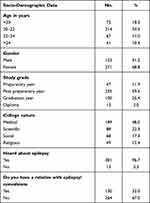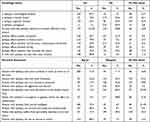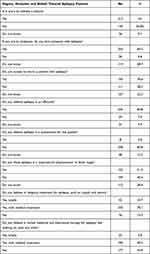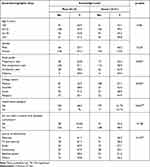Back to Journals » Neuropsychiatric Disease and Treatment » Volume 18
Epilepsy Stigma Among University Students in Makkah: A Cross-Sectional Study
Authors Alkhotani AM , Alkhotani AM
Received 21 January 2022
Accepted for publication 3 May 2022
Published 17 May 2022 Volume 2022:18 Pages 1047—1056
DOI https://doi.org/10.2147/NDT.S359472
Checked for plagiarism Yes
Review by Single anonymous peer review
Peer reviewer comments 2
Editor who approved publication: Dr Roger Pinder
Amal M Alkhotani,1 Alaa M Alkhotani2
1Department of Medicine, Umm Al-Qura University, Makkah, 21955, Saudi Arabia; 2Department of Pathology, Umm Al-Qura University, Makkah, 21955, Saudi Arabia
Correspondence: Amal M Alkhotani, Department of Medicine, Umm Al-Qura University, Makkah, Saudi Arabia, Email [email protected]
Background: Epilepsy is a neurological disorder characterized by a persistent propensity to generate recurring epileptic seizures. Young adults such as university students can bridge the gap and improve attitudes toward patients with epilepsy and reduce stigma. This study aims to assess the knowledge and attitude of university students in the city of Makkah about epilepsy.
Methods: This cross-sectional descriptive study was carried out at main universities in the Makkah region of Saudi Arabia. The study was conducted after getting approval from Umm Al-Qura University’s ethics and research committee. A total of 394 participants were enrolled in the study, and a stratified random sampling (probability sampling) technique was used to select respondents.
Results: The study included students with a mean age of 20.9 ± 4.6 (18– 28 years), 271 (68.8%) students were females, 374 (94.9%) of the students agreed that epilepsy is not contagious, and 215 (54.6%) refused the impact of epilepsy on patients’ marital status, relationships and fertility, respectively, 213 (54.1%) of the students reported that they feel scared to witness a seizure. About 334 (84.8%) respondents believed that epilepsy is an affliction, and 123 (31.2%) reported that they thought epilepsy was a supernatural phenomenon or black magic.
Conclusion: The study concluded a satisfactory level of awareness among university students in Makkah related to dealing with patients with epilepsy. Further scientific studies will help build student’s positive attitudes through simulation programs and interventional studies.
Keywords: people with epilepsy, stigma, epileptic seizures, Saudi community, neurological disorder
Introduction
Epilepsy is a neurological disorder characterized by a persistent propensity to generate recurring epileptic seizures. The “International League against Epilepsy – ILAE” explained epilepsy with the presence of 1) at least two reflex or unprovoked seizures within the period of >24 hours apart or 2) probability of further seizures and one unprovoked seizure with a general reoccurrence risk of 60%, after two reflex seizures, occurring over next ten years or 3) epileptic syndrome diagnosis.1,2 Around 65 million live with epilepsy globally, with a pooled incidence rate of 61.4 every 100,000 people per year, out of which 4.7 million people with epilepsy are from Middle East countries.3,4 The studies suggest higher epilepsy incidence in lower-middle-income countries 139.0 (95% CI 69.4–278.2) in comparison to high-income countries 48.9 (95% CI 39.0–61.1).5 The estimated prevalence of epilepsy in Saudi Arabia (KSA) is 6.54 every 1000 persons. The cumulative prevalence of medically resistant epilepsy (MRE) in KSA is 30%.6,7 Similarly, the prevalence of epilepsy is highest in adolescence and early childhood. The estimated prevalence for age 10–19 is 8.86 (95% CI (6.58–11.92) and for age 20–29 is 9.14 (95% CI (7.17–11.64).8
In some places, epilepsy is regarded to be linked to mental reasons; in others, supernatural beliefs and epilepsy are thought to be linked. Epilepsy patients confront several challenges. Recurrent seizures,9 or the etiology of epilepsy,2 drug adverse effects,10 and major psychosocial and neurocognitive issues11 are all part of it. This has a significant influence on people with epilepsy (PWE). That belief and misconception of epilepsy resulted in the mistreatment of epilepsy patients. Across several nations, PWE suffered from different degrees of stigmatization and PWE isolation. Several studies have shown stigmatization and poor knowledge about epilepsy. Over the years, public knowledge about epilepsy has improved in several countries. Still, it remained a significant problem in others. In KSA, studies showed improvements in knowledge across the years, but despite the health education toward improving knowledge about epilepsy, there are still gaps in knowledge and attitude.12–14
For generations, in the Saudi community, an association between spirits possession and stigmatization of epileptic patients is believed.15 Young adults, such as university students, can bridge the gap, improve PWE attitudes, and reduce stigma. Young adults are a potentially vital source to change the public attitude toward epilepsy patients. They can affect the younger generation and spread the correct information among older generations. This study aims to assess the knowledge and attitude of university students in the city of Makkah about epilepsy.
Materials and Methods
This cross-sectional descriptive study was carried out at the main universities in the Makkah region of Saudi Arabia from November 2021 till January 2022. The study was conducted after approval from Umm Al-Qura University’s ethics and research committee (Approval No. HAPO-02-K-012-2021-11-84). A total of 394 participants were enrolled in the study. A stratified random sampling (probability sampling) technique selected respondents. The sample size was calculated using the “Raosoft” calculator with a 5% margin of error, 95% confidence level, and 50% response distribution.
The study included respondents enrolled in universities only in the Makkah region, able to understand Arabic and English, above 18 years of age, and willing to participate in the study. Students with epilepsy history and incomplete responses to the questionnaire were excluded from the study. The study utilized an electronic self-administered questionnaire adapted and modified from previous studies with a cover letter stating the study objective. The respondents willing to participate in the study filled out the informed consent and agreed to the study objective before filling out the questionnaire. The questionnaire was distributed electronically among university students in the Makkah region. Two independent researchers (A) and (B) reviewed the questionnaire, and the participant’s identity was kept confidential.
The questionnaire consisted of 30 questions, divided into three sections, including participant’s demographic details (age, gender, year of study, type of college, etc), knowledge about epilepsy, and stigma-related questions. The questionnaire used a (Yes/No/Do not Know) and (Agree/Disagree/Do not Know) nominal scale. For knowledge and perceived awareness items, each correct answer was scored one point, and the total summation of the discrete scores of the different items was calculated. A participant with a score less than 60% (0–12 points) of the total score was considered poor awareness, while good awareness was considered if he had a score of 60% (13 points or more) of the total or more.
Statistical Analysis
After data were extracted, it was revised, coded, and fed to statistical software IBM SPSS version 22.0 (SPSS, Inc. Chicago, IL). All statistical analysis was done using two-tailed tests. A P-value less than 0.05 was considered statistically significant. Descriptive analysis based on the frequency and percent distribution was done for all variables, including students’ socio-demographic data, study grade, family and personal history of epilepsy, and source of information regarding epilepsy. Also, participants’ knowledge and perceived awareness regarding epilepsy and their stigma and attitude towards epilepsy patients were shown in frequency tables. Cross tabulation was used to assess the distribution of students’ knowledge level and awareness regarding epilepsy according to their data, family history, and source of information. Relations were tested using the Pearson chi-square test and exact probability test for small frequency distributions.
Results
A total of 394 university students completed the study questionnaire. Table 1 demonstrates the participant’s demographic details. The study included students with a mean age of 20.9 ± 4.6 with a female preponderance (n=271, 68.8%). The majority of the students (n=235, 59.6%), were in their intermediate years followed by 100 (25.4%) were in their graduation year, and 47 (11.9%) were in their preparatory year. Considering student type of colleges, 189 (48%) participants were enrolled at the college of medicine, 88 (22.3%) at scientific colleges, 68 (17.3%) at social colleges, and 49 (12.4%) at religious colleges. Three hundred and eighty-one (96.7%) students heard about epilepsy, while 130 (33%) had a family relative with epilepsy.
 |
Table 1 Socio-Demographic Data of Enrolled Participants (University Students) in Makkah, Saudi Arabia |
The study also evaluated the knowledge and perception of university students regarding epilepsy in Makkah, Saudi Arabia (Table 2). The results showed 326 (82.7%) students were aware of epilepsy as a neurological disorder, and 219 (55.6%) agreed that it is not a psychological disorder. In total, 338 (85.8%) of the students decided that children with epilepsy can play with other children. However, 331 (84%) participants believed that epilepsy could affect patients driving. On the other hand, 374 (94.9%) of the students agreed that epilepsy is not contagious, and 215 (54.6%) refused the impact of epilepsy on patients’ marital status, relationships and fertility, respectively. In total, 194 (49.2%) respondents refused epilepsy impact on patients’ daily physical activities like sports, and 153 (38.8%) did not believe in any difference in epileptic patients treatment from other regular patients. Regarding perceived awareness, 356 (90.4%) of the study students disagreed that patients with epilepsy are aggressive and abusive, 271 (68.8%) opposed to the patient with epilepsy is contagious or genetic, which may affect his relationships, 240 (60.9%) participants refused that patient with epilepsy may cause discomfort to the people around him, and 189 (48%) refused that patient with epilepsy suffer from personality disorders more than others. Additionally, 316 (80.2%) agreed that epileptic patients could live as normal as others.
 |
Table 2 University Students’ Knowledge and Perception Regarding Epilepsy in Makkah, Saudi Arabia |
The university students’ stigma, attitude and belief towards epilepsy patients in Makkah, Saudi Arabia, was studied and demonstrated in Table 3. In total, 213 (54.1%) of the students reported that they feel scared to witness a seizure. About 334 (84.8%) respondents believed that epilepsy is an affliction, and 123 (31.2%) reported that they think of epilepsy as a supernatural phenomenon or black magic. The majority of the students (85.8%) disagreed with epilepsy as a punishment for the patient, and 254 (64.5%) agreed as an employer to hire someone with epilepsy. Moreover, 156 (39.6%) accepted to marry a person with epilepsy, and 276 (70.1%) believed in religious treatment for epilepsy, such as ruqyah along with medical treatment, while only 42 (10.7%) believed totally in spiritual therapy for epilepsy. Also, 194 (49.2%) believed in herbal medicine and alternative treatment for epilepsy like walking on sand for better recovery from epilepsy.
 |
Table 3 University Students’ Stigma, Attitudes and Beliefs Towards Epilepsy Patients, Makkah, Saudi Arabia |
Figure 1 demonstrates university students’ knowledge and perception regarding epilepsy, Makkah, Saudi Arabia. A total of 200 students (50.8%) had a good knowledge level and perception regarding epilepsy patients, and 194 (49.2%) had poor knowledge and perception level.
 |
Figure 1 Overall university students’ knowledge and perception regarding epilepsy, Makkah, Saudi Arabia. |
Figure 2 presents the relationship between the source of university students’ knowledge and perception regarding epilepsy in Makkah, Saudi Arabia. The results showed that study was the most reported source of knowledge (32%), followed by TV and internet (20.6%), community (18.5%), relative patient (16.2%) while physicians were reported by 6.1% of the students, respectively.
 |
Figure 2 Source of university students’ knowledge and perception regarding epilepsy, Makkah, Saudi Arabia. |
Table 4 demonstrates the association between university students’ knowledge level and perception regarding epilepsy by their socio-demographic data. A statistically significant difference was observed between different study grade students (P-value: 0.025). Similarly, a statistically significant difference (P-value: 0.049) was reported among students studying in medical colleges (57.1%) in comparison to social (48.5%), religious (44.9%), and scientific colleges (42%), respectively.
 |
Table 4 University Students’ Knowledge Level and Perception Regarding Epilepsy by Their Socio-Demographic Data |
Discussion
The study looked at the stigma associated with epilepsy among university students in Makkah. The findings revealed that 54.3% were between the ages of 20 and 22, with a mean age of 20.9 ±4.6 (18–28 years) and that the majority of respondents were female (68.8%) and male (31.2%), respectively. In contrast, research done in Qassim, Saudi Arabia, found that males (59.3%) were more likely to participate than females (40.6%), with 59.7% of respondents aged 15–30 years.16 Forty-eight percent of our research was from medical universities. Shihata et al6 did another research among medical students at King Abdul-Aziz University in Jeddah. It revealed students’ misconceptions about the causes of epilepsy, treatment options, and attitudes toward epileptic patients. Hakami et al15 also found that health colleges had a superior understanding of how to distinguish epilepsy from other illnesses. Medical students also know about epilepsy as a medical illness, according to Alsaab et al.17 Results showed 86.8% of the students were positively able to distinguish seizure as abnormal electrical discharge in the brain.
In our study, we assessed the knowledge and perceptions of university students in Makkah, Saudi Arabia, about epilepsy. The results showed that 374 (94.9%) of the students agreed that epilepsy is not contagious, and 215 (54.6%) of the students denied the impact of epilepsy on patients’ marital status, relationships, and fertility. In a survey done by Ghaffar et al18 in the Aseer region of Saudi Arabia, 95.8% of the participants disputed that epilepsy is a contagious illness. The population’s knowledge regarding epilepsy improved in KSA in the past few years as the percentage of believers in epilepsy as contagious decreased in different regions decreased relatively.14,17,19,20 PWE marital chances were researched by Almarzouqi et al,23 who found that socio-demographic characteristics, such as employment, had a substantial impact on PWE matrimonial prospects. Similarly, PWE’s social history adds to the stigma that surrounds patients, resulting in a negative attitude toward PWE in social relationships, employment, and education. As a result, social support can help with non-clinical problems about PWE.24 In our study, 18.3% of the people thought epilepsy was a mental condition, 82.7% thought it was a neurological problem, and 32.7% thought it was a hereditary issue. Another research24 found that 17.1% of the people thought epilepsy was caused by a hereditary issue, and 60% thought it was caused by brain illnesses. Epilepsy problems and accompanying seizures can have a social impact and stigmatize PWEs in a variety of ways. According to our research, 64.5% of university students in Makkah would hire PWE if given the opportunity. This conclusion is in line with the findings of other studies.18,21,22 Approximately 334 (84.8%) respondents believe epilepsy is a disease, while 123 (31.2%) believe epilepsy is a supernatural phenomenon or black magic, indicating a negative attitude toward epilepsy, implying that despite public awareness efforts and modern education, a negative perception of PWE still exists in Saudi Arabia. This situation also exists in other Middle Eastern nations, such as the United Arab Emirates25 and Iran.26 Another research performed among university students in Kuwait27 found that a quarter of the participants believe in bad spirits as the cause of epilepsy, which is five times greater than the Malaysian study.28 Discrimination against PWE in educational institutions and the workplace deprives participants of their right to equal opportunity.
These abuses of social and civic rights were visible in emerging nations. However, 64.5% of the students agreed to hire PSE in the workplace in our survey. Research in Saudi Arabia15 found a strong link between university students’ degree of knowledge and the reduction of stigma among diverse professions (P<0.001) and encouraged epileptic patients to consult with healthcare specialists. Overall, our research revealed that university students in Makkah had a good attitude regarding coping with PWE. The study’s weakness was the limited exposure and understanding of certain students when filling out the questionnaire. Every year, the Saudi Epilepsy Society Chapter holds educational events in the community to raise awareness of the problems, insecurities, and stigma associated with epilepsy, as well as to provide training in the first aid care of PWE and seizures.1 However, further research at the university level is needed to eliminate societal stigma, raise epileptic patient awareness, and improve quality of life in PWE.
Conclusion
This study concluded that university students in Makkah have a satisfactory level of awareness related to epilepsy. The present study found that graduation year students had a good knowledge level. However, there is still a requirement to improve knowledge and attitude toward PWE to reduce the stigma and misconceptions associated with epilepsy among the population in Makkah through intervention programs. This can be attained by incorporating further training and educational awareness programs at the higher education level in universities about the nature of the disease and its treatment, along with the overall social role of the community. Through simulation programs and interventional studies, further scientific studies will help build students’ positive attitudes among youth and adults.
Abbreviations
KSA, Kingdom of Saudi Arabia; MRE, medically resistant epilepsy; ILAE, International League against Epilepsy; PWE, people with epilepsy.
Data Sharing Statement
The datasets used and analyzed during the current study are available from the corresponding author on reasonable request.
Ethics Approval
This study was approved by the Umm Al-Qura University’s ethics and research committee. This study adhered to the principles of the Declaration of Helsinki.
Consent for Publication
Participants were informed that their participation is anonymous and their responses are confidential.
Acknowledgment
The authors would like to thank the data collectors (Wesam Mandoura, Ameerah Mandourah, Ibrahim Alfahmi, Yousra Alturki) for their help in collecting the data from study participants.
Author Contributions
All authors made a significant contribution to the work reported, whether that is in the conception, study design, execution, acquisition of data, analysis and interpretation, or in all these areas; took part in drafting, revising or critically reviewing the article; gave final approval of the version to be published; have agreed on the journal to which the article has been submitted; and agree to be accountable for all aspects of the work.
Disclosure
Dr Amal M Alkhotani reports grants from Umm Al-Qura University, during the conduct of the study. The authors report no other conflicts of interest in this work.
References
1. Kissane N, Balili K, Mesraoua B, et al. Epilepsy and school in the Middle East and North Africa (MENA) region: the current situation, challenges, and solutions. Epilepsy Behav. 2020;112:107325.
2. Fisher RS, Acevedo C, Arzimanoglou A, et al. ILAE official report: a practical clinical definition of epilepsy. Epilepsia. 2014;55:475–482. doi:10.1111/epi.12550
3. Singh G, Sander JW. The global burden of epilepsy report: implications for low-and middle-income countries. Epilepsy Behav. 2020;105:106949. doi:10.1016/j.yebeh.2020.106949
4. World Health Organization. Epilepsy in the WHO Eastern Mediterranean Region: Bridging the Gap. Cairo, Egypt: World Health Organization, Regional Office for the Eastern Mediterranean; 2010.
5. Beghi E, Hesdorffer D. Prevalence of epilepsy—an unknown quantity. Epilepsia. 2014;55:963–967. doi:10.1111/epi.12579
6. Shihata SS, Abdullah TS, Alfaidi AM, et al. Knowledge, perception and attitudes toward epilepsy among medical students at King Abdulaziz University. SAGE Open Med. 2021;9:2050312121991248. doi:10.1177/2050312121991248
7. Alshurem M, Aldosari MM, Aljaafari D, et al. Prevalence of medically resistant epilepsy in Saudi Arabia. Neuroepidemiology. 2021;55:232–238. doi:10.1159/000515743
8. Fiest KM, Sauro KM, Wiebe S, et al. Prevalence and incidence of epilepsy: a systematic review and meta-analysis of international studies. Neurology. 2017;88:296–303. doi:10.1212/WNL.0000000000003509
9. Alkhotani AM, Alkhotani AM. Effect of health education on female primary school teachers’ knowledge of seizure first aid: an interventional study. Epilepsy Behav. 2022;127:108523. doi:10.1016/j.yebeh.2021.108523
10. Sen A, Jette N, Husain M, Sander JW. Epilepsy in older people. Lancet. 2020;395:735–748. doi:10.1016/S0140-6736(19)33064-8
11. Semple BD, Zamani A, Rayner G, Shultz SR, Jones NC. Affective, neurocognitive and psychosocial disorders associated with traumatic brain injury and post-traumatic epilepsy. Neurobiol Dis. 2019;123:27–41.
12. Tayeb HO. Epilepsy stigma in Saudi Arabia: the roles of mind-body dualism, supernatural beliefs, and religiosity. Epilepsy Behav. 2019;95:175–180. doi:10.1016/j.yebeh.2019.04.022
13. Fernandes PT, Snape DA, Beran RG, Jacoby A. Epilepsy stigma: what do we know and where next? Epilepsy Behav. 2011;22:55–62. doi:10.1016/j.yebeh.2011.02.014
14. Algahtani H, Shirah B, Alzahrani A, Shaheen M. Perception and attitude of the general population towards epilepsy in Jeddah, Saudi Arabia. J Epilepsy Res. 2019;9:42. doi:10.14581/jer.19005
15. Hakami T, Mahfouz M, Najmi H, et al. Knowledge of and attitude towards epilepsy among university students in Saudi Arabia: misconceptions of the next generation. Epilepsy Behav Rep. 2021;16:100450. doi:10.1016/j.ebr.2021.100450
16. Altowayan R, Aloqaily H, Almutairi A, et al. Level of awareness and attitudes toward epilepsy in Qassim, Saudi Arabia: a cross-sectional study. Epilepsy Behav. 2019;90:66–69. doi:10.1016/j.yebeh.2018.10.044
17. Alsaab AS, Almutairy AN, Ahmed SM, Alotaibi AA, Alshaikh H, Alotaibi KA. A study of basic knowledge of epilepsy among male medical students in Majmaah University, Riyadh, Saudi Arabia, in 2018. IJMRHS. 2019;4:116–120.
18. Ghaffar NF, Asiri RN, Al-Eitan LN, et al. Improving public stigma, sociocultural beliefs, and social identity for people with epilepsy in the Aseer region of Saudi Arabia. Epilepsy Behav Rep. 2021;16:100442.
19. Al-Dossari KK, Al-Ghamdi S, Al-Zahrani J, et al. Public knowledge awareness and attitudes toward epilepsy in Al-Kharj Governorate Saudi Arabia. J Family Med Primary Care. 2018;7:184. doi:10.4103/jfmpc.jfmpc_281_17
20. Alhazzani AA, Alqahtani AM, Abouelyazid A, et al. Public awareness, knowledge, and attitudes toward epilepsy in the Aseer region, Saudi Arabia—a community-based cross-sectional study. Epilepsy Behav. 2016;63:63–66. doi:10.1016/j.yebeh.2016.07.041
21. Muthaffar OY, Jan MM. Public awareness and attitudes toward epilepsy in Saudi Arabia is improving. Neurosci J. 2014;19:124–126.
22. Abdulkarim AR. Societal problems that patients with epilepsy are facing in Sharjah, UAE. Epilepsy Behav. 2016;59:142–146. doi:10.1016/j.yebeh.2016.02.026
23. Almarzouqi M, Alageel S, Almeharish A, Alsemari A. Marital status among patients with epilepsy in Saudi Arabia. Epilepsy Behav. 2022;126:108452. doi:10.1016/j.yebeh.2021.108452
24. Asadi-Pooya AA, Homayoun M, Keshavarz S. Education, marriage, and employment in people with epilepsy: the barriers that patients perceive. Int J Epilepsy. 2020;6:50–3.
25. Alsaadi T, Kassie S, El Hammasi K, et al. Potential factors impacting the health-related quality of life among patients with epilepsy: results from the United Arab Emirates. Seizure. 2017;53:13–17. doi:10.1016/j.seizure.2017.10.017
26. Ghanaian H, Nojomi M, Jacobsson L. Public awareness and attitudes towards epilepsy in Tehran, Iran. Glob Health Action. 2013;6:21618. doi:10.3402/gha.v6i0.21618
27. Al-Rashed H, Al-Yahya D, Al-Kandari A, Al-Sabah R, Al-Taiar A, Al-Taiar A. Knowledge of, perceptions of, and attitudes toward epilepsy among university students in Kuwait. Epilepsy Behav. 2009;14:367–371. doi:10.1016/j.yebeh.2008.11.015
28. Ab Rahman AF. Awareness and knowledge of epilepsy among students in a Malaysian university. Seizure. 2005;14:593–596. doi:10.1016/j.seizure.2005.09.005
 © 2022 The Author(s). This work is published and licensed by Dove Medical Press Limited. The full terms of this license are available at https://www.dovepress.com/terms.php and incorporate the Creative Commons Attribution - Non Commercial (unported, v3.0) License.
By accessing the work you hereby accept the Terms. Non-commercial uses of the work are permitted without any further permission from Dove Medical Press Limited, provided the work is properly attributed. For permission for commercial use of this work, please see paragraphs 4.2 and 5 of our Terms.
© 2022 The Author(s). This work is published and licensed by Dove Medical Press Limited. The full terms of this license are available at https://www.dovepress.com/terms.php and incorporate the Creative Commons Attribution - Non Commercial (unported, v3.0) License.
By accessing the work you hereby accept the Terms. Non-commercial uses of the work are permitted without any further permission from Dove Medical Press Limited, provided the work is properly attributed. For permission for commercial use of this work, please see paragraphs 4.2 and 5 of our Terms.
